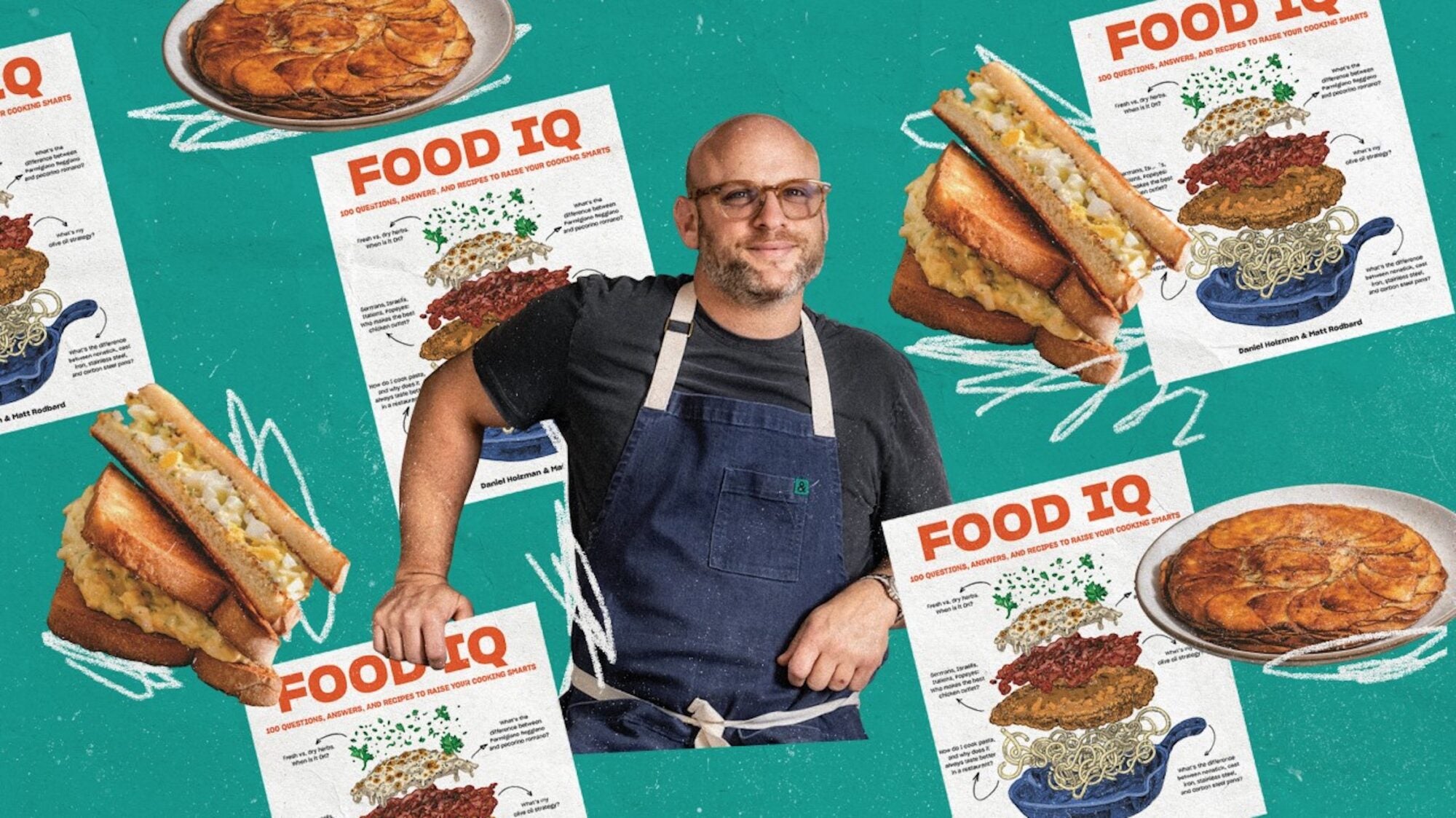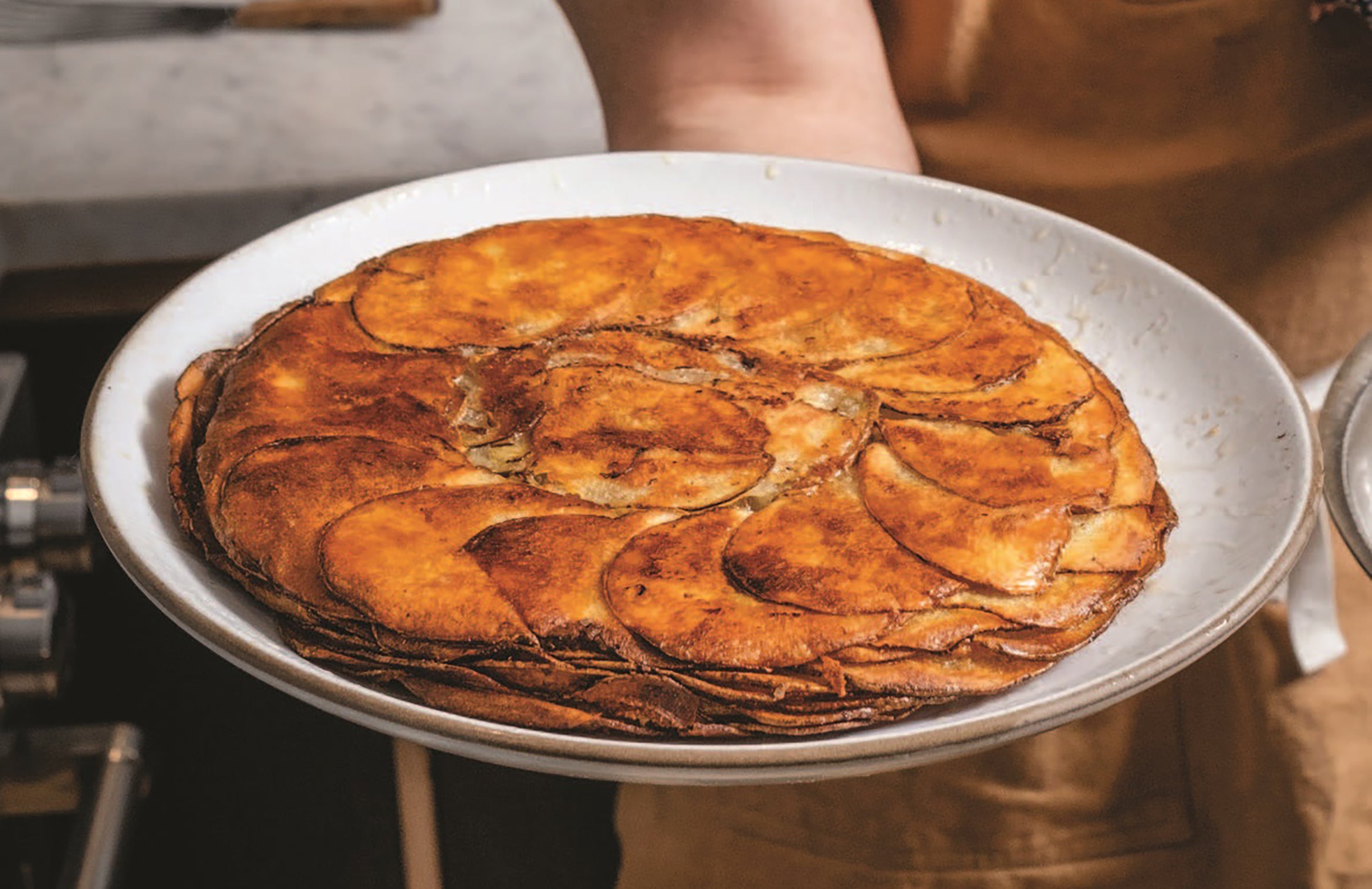
Two authors tackle some of the most commonly asked questions in cooking and food culture today.
Many people know Daniel Holzman for his meatball expertise, as the cofounder of The Meatball Shop in New York and the coauthor of The Meatball Shop Cookbook. But Holzman is also a studious home cook with serious opinions about everything from the best popcorn toppings to the ideal scrambled egg technique.
Holzman has explored some of these topics in the pages of TASTE, in his column 100 Questions for My Friend the Chef, cowritten with TASTE editor in chief Matt Rodbard. In a new cookbook, Food IQ: 100 Questions, Answers, and Recipes to Raise Your Cooking Smarts, the pair tackles some of the most frequently asked questions out there about cooking—about the gear, ingredients, and moves every home cook should consider essential. I took a crack at stumping Holzman with some of my own burning food questions.
Let’s talk about homemade versus store-bought chicken broth versus bouillon cubes. I love to make my own chicken broth, but I don’t always have it ready to go when I’m braising or making a stew. When you have to rely on store-bought products, do you reach for the box of broth or bouillon first?
I’m a Better Than Bouillon guy by choice; I just think it’s the best product out there. That said, the Knorr concentrates are great quality as well. Generally speaking, the cubes, liquid concentrate, and broth from the box are interchangeable, with the only caveat being that the boxed broth comes in a low-sodium version, which is a better option if you intend to reduce the end product, as in a sauce or gravy. When reducing the salt, concentrates can be overwhelming if you’re not careful.
You dive a lot into food safety in the book, which I think is a big source of insecurity for people who are cooking meat or fish for the first time. What’s the biggest misconception when it comes to general home cooking food safety?
The big misconception revolves around meat and seafood. People are constantly concerned that they will eat an off slice of meatloaf or a fouled oyster. But meat and seafood emit extraordinarily pungent malodorous fumes when they begin to sour—even with a full-on case of Covid, you’d be hard-pressed to accidentally enjoy a spoiled piece of meat. Salad, on the other hand, and other ingredients that grow close to the ground and are eaten raw, tend to be the carriers of the truly maleficent contagions—mostly deposited by deer and other animals that carry germs on their hooves as they graze through the fields. Many of the bacteria that live on raw ingredients are odorless and flavorless.
I made the Marinated Roast Chicken with Sumac, Lemon, and Salt the other week—and it was great. Counter to my usual chicken roasting strategy, the recipe involves cooking at a low temperature, cooling for 30 minutes, and then roasting in a very hot oven to finish and brown the skin. Why does this work?
Glad you liked it! The big issue here comes down to the difference in temperature between your oven and your final desired cooking temperature. You want to bring the internal temperature of your chicken to 135 degrees Fahrenheit (or you can follow the FDA guidelines, which define safely cooked chicken as a chalk-dry, grumblingly overcooked 165 degrees). If you start with an oven temperature in the 400s, the outside of your chicken will be way overcooked before the center reaches the correct temperature. For us, the ideal cooking method is low and slow, so the chicken cooks evenly, remaining moist throughout. The resting period helps distribute the juices as the heat continues to penetrate to the core. Once rested (the most underappreciated and overlooked step in the process of cooking any meat), the chicken is heated back up in a searingly hot oven, crisping the skin quickly without overcooking the flesh.
Your meatball recipe skips out on the milk that’s often included to soften the bread, but it calls for hot cherry pepper pickling liquid. It never occurred to me to just swap in something acidic for that liquid. Why does it work? And what other milk substitutes have you tried?
Meatballs are a peasant food. Most meatball recipes are designed to take a small amount of meat and mix it with fillers, flavorings, and other ingredients to help feed a whole family from a few mere morsels. One of the best filler ingredients was stale bread, which needs to be reconstituted in order to crumble and mix properly. In that case, soaking the bread in liquid is necessary. Milk is a great option because the lactic acids tenderize, sugars sweeten, and fat moistens the meatballs. For our recipe, we substitute fresh bread, which doesn’t need to be rehydrated, and we add the pickling liquid for flavor more than for texture. And yes, I’ve put just about everything you can imagine into a meatball, including ginger ale, which makes a delicious turkey meatball.
I know from some of your writing for TASTE that you’re no snob when it comes to cooking with frozen vegetables. What are three MVPs of your freezer—vegetables or any frozen ingredient that you try to always keep around?
I always have frozen shrimp on hand, pints of chicken stock, and a loaf of sliced bread. The shrimp because there’s nothing more versatile for a quick, healthy meal, whether you’re poaching a quick cocktail or making a stir-fry. The bread because I don’t eat at home often enough to utilize a full loaf before it stales, and the freezer extends the life almost indefinitely. The stock because I often make small amounts of chicken stock from the scraps and bones of single servings. One chicken back makes about a pint of stock, which is the perfect amount for a single serving of risotto or a small batch of soup or beans.

FOUR EXCITING RECIPES FROM FOOD IQ:
Marinated Roast Chicken with Sumac, Lemon, and Salt
A low-and-slow roast, followed by a rest and a quick blast of high heat, locks in the juice while keeping that skin brown and crisp.
The Best Egg Salad Sandwich
A bright, springy, lemon-and-chive take on the classic.
Pommes Anna
The most impressive side dish you can make with two ingredients.
The Cast Iron Quesadilla That Will Change the Way You Quesadilla
All frico, all the time.